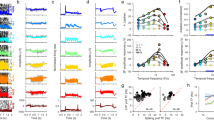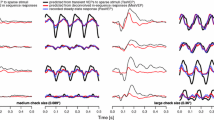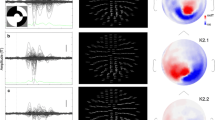Abstract
The characteristics of the first and the second order kernels of the visually evoked potentials (VEPs) elicited by pseudorandom binary sequence (PRBS) stimuli were investigated. VEPs were recorded from six eyes of four normal volunteers. The effects of stimulus luminance on the latency and amplitude of the first and the second order kernels were determined. The temporal interactions of transient VEPs elicited by single and double pulse stimuli were compared with the first and the second order kernels of the PRBS-VEPs. The correlation coefficient between the logarithm of the stimuli luminance (log I) and VEP amplitude of the first order kernels was 0.45 (p < 0.05), and that between log I and P1 latency was −0.62(p < 0.005). The second order kernels were not equal to the temporal interactions of the responses. However, the latency of the negative peak of the fourth slice was similar to the temporal interaction to double pulse stimulation with an inter-stimulus interval of 40 ms. An inhibitory component at 40 ms following the first stimulus was detected in the analysis of both PRBS-VEPs second order kernel and transient VEPs. This function may help to increase the frequency of critical flicker fusion in normal subjects.
Similar content being viewed by others
References
Srebro R, Wright W. Pseudorandom sequence in the study of evoked potentials. Ann N Y Acad Sci 1982; 388: 98–112.
Srebro R. An analysis of the VEP to luminance modulation and of its nonlinearity. Vision Res 1992; 32: 1395–404.
Collins AD, Sawhney BB. Pseudorandom binary sequence stimulationapplied to the visual evoked response. Normative data and a comparative study with pattern and flash stimulation. Doc Ophthalmol 1993; 83: 163–73.
Kitano M, Kuroda R, Arita N et al. Adaptation of non-linear analysis system by PRBS for electro-physiology. 1. Evaluation of temporal mutual interference in visual evoked potential. Encephalogram and Electromyography 1994; 22: 321–31.
Musselwhite MJ, Jeffreys DA. Visual evoked potentials to double-pulse pattern presentation. Vision Res 1983; 23: 135–43.
Yamamoto N, Yasuma T. Clinical application of the timedependent perimetry (8). The regional difference with aging. NipponGan ka Gakkai Zasshi (Acta Societatis Ophthalmologicae Japonicae) 1988; 92: 591–602.
Momose K, Kiyosawa M, Nemoto N et al. Visual temporal frequency characteristics determined by pseudorandom stimuli. Invest Ophthalmol Vis Sci 1999; 40: 50–4.
Mori H, Momose K, Nemoto N et al. Applicationof visual evoked potentials for preoperative estimation of visual functionineyes with dense cataract. Graefe's Arch ClinExp Ophthalmol 2001; 239: 915–22.
Nemoto N, Mori H, Kiyosawa M et al. Visually evoked potentials elicited by pseudorandom stimulation from patients with macular degeneration. Jpn J Ophthalmol 2002; 46: 108–13.
Sutter EE, The fast m-transform: a fast computation of cross-correlationwith binary m-sequences. SIAM J Comput 1991; 20: 689–94.
Author information
Authors and Affiliations
Rights and permissions
About this article
Cite this article
Nemoto, N., Momose, K., Kiyosawa, M. et al. Characteristics of first and second order kernels of Visually Evoked Potentials elicited by pseudorandom stimulation. Doc Ophthalmol 108, 157–163 (2004). https://doi.org/10.1023/B:DOOP.0000036785.01781.fa
Issue Date:
DOI: https://doi.org/10.1023/B:DOOP.0000036785.01781.fa




